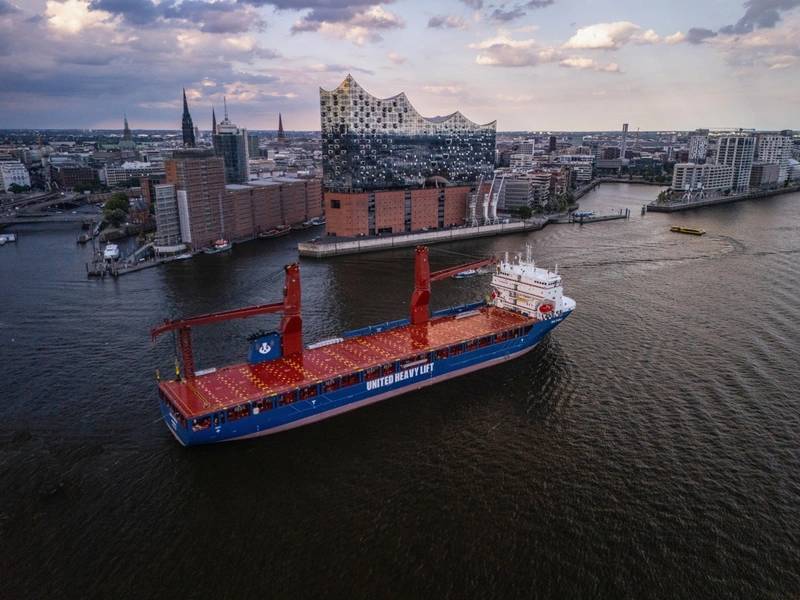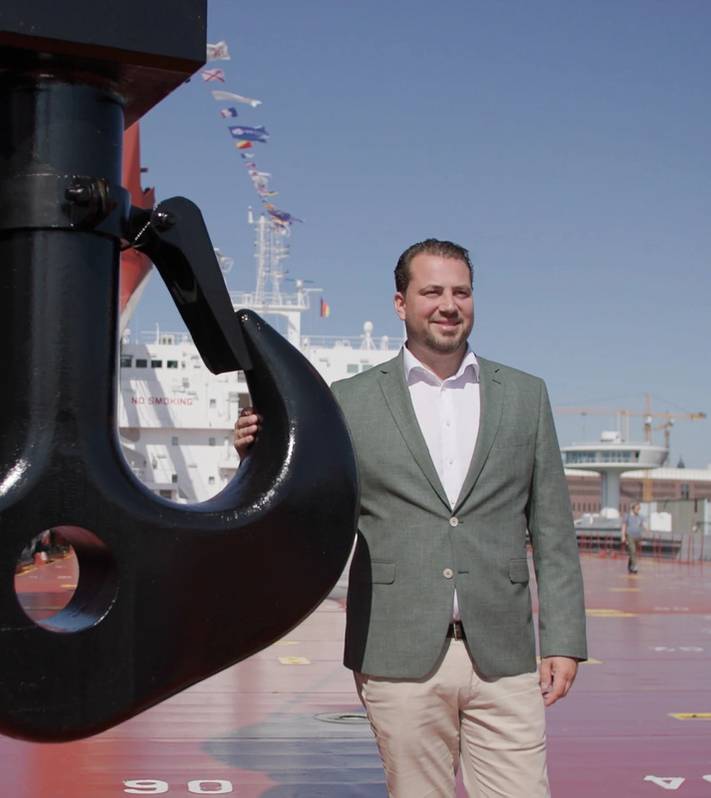HEAVY HAULER: Andreas Rolner Powers UHL Ahead
Just shy of 10 years old, United Heavy Lift (UHL) recently welcomed its 19th ship to the fleet, an F900 eco-lifter. In advance of the ship delivery festivities in mid-July, we had the chance to chat with Andreas Rolner, Managing Director of UHL, a man who with his father parlayed cumulative experience in the heavy lift business into one of the world’s largest heavy lift companies.
“Shipping has always been a part of my DNA,” said Andreas Rolner, noting his family moved from Denmark to Germany when he was a young boy, and his father Lars joining SAL back then in 1980. Andreas officially started his own shipping career in 2006, but unofficially his summer holidays were spent like many adolescents in strong shipping families: with his father in the [SAL] office.
After about 10 years of experience traveling the globe working in shipping, in 2015 “Lars and I decided to launch UHL.”
Today, UHL is part of the United Shipping Group based in Hamburg's HafenCity, with a worldwide team of 150 employees in 10 offices globally.
Watch the full interview with Andreas Rolner, Managing Director of UHL, on Maritime Reporter TV:
From the Ashes [of Zeamarine]
“End of 2014, beginning of 2015, the market was a different one,” said Rolner. “We saw that German banks were becoming ship owners, a situation they did not want to be in.”
So team father and son started off doing commercial management on a transparent, open book basis for banks.
“We took fixed commissions; we did cash flow projections; we took over all of the services [where they didn't want the hassle]. We started running these ships as our own, and, with time, we made enough cash also to charter vessels on our own.”
The big break came with Zeamarine going out of business, allowing UHL to take over the F900s.
“Back then, it was a big gamble,” said Rolner. “Vessels were expensive. [But we] phased out the older tonnage, and we went from this small operator doing commercial management now to placing our own orders and now looking at a new generation of vessels. It's been a nice voyage.”
“We took over the vessels from Zeamarine when they went bust four years ago,” said Rolner. “With the latest new building [UHL Fable, a F900 Eco-Lifter, a multi-purpose (MPP) heavy lift vessel, built at the CSSC Hudong Shipyard in Shanghai] we're at 19 vessels, 19 identical F900 eco-lifters, [which gives us] the youngest, most modern and most homogeneous fleet in the market.”
While Rolner is not particularly enamored with an odd number fleet size of 19, he does not see the need to order more F900s, though he does admit “we are developing our successor to the ship. In shipping, of course, it's all about timing. When is the right time to approach the yards? When it's the right time to look at financing? If we had a crystal ball, it would be nice, but no, right now, it's a difficult decision.”
He said the new ship design is almost complete, and in the coming months it may approach shipyards for build quotes.
 Image courtesy UHL
Image courtesy UHL
In for the Long Haul
From the start, the UHL vision has been long-term, and with that it has a vessel contracting philosophy that seeks strong, long-term contracts for big projects; but at the same time it has the vessels and crews to tap the spot market, too.
“Right now, for the rest of this year, the vessels are basically booked out,” said Rolner. “Until 2028, we already booked 30% of the capacity of the fleet for the long-term projects, and I think that will go up maybe to around 50%. I think it's a healthy 50/50 [split between contracts and spot].”
The wind turbine business specifically, renewable energy in general, has been a big driver in the heavy lift sector for years. “Especially onshore has been massive, that's where the volume is,” said Rolner. “But it is shifting fast. We see that oil and gas is coming back on track,” effectively expanding UHL's exposure across energy markets.
While the energy markets are fluid, growing and in need of heavy lift, UHL is not immune from the challenges that provide headwinds for all international shipping today, namely:
One-Way Roads: “We see 95% of the export is out of Asia; there's not a lot of export coming out of Europe. In the end, we might have to send the vessels back empty just to cater for the contracts that we have in place.”
Freedom of Navigation: With Iranian-backed Houthis attacking ships at will in the Red Sea and a prolonged low-water situation at the Panama Canal, two major shortcuts have been eliminated and/or minimized. “We are routing around the Cape, and that's costing us 10 days each way. If you have commitments of three to four shipments every month, it's quite challenging.”
 Image courtesy UHL
Image courtesy UHL
The Future Fleet
As any shipowner knows, there are inherent advantages to operating a fleet of identical ships, and though “on a piece of paper they all look alike, there are a few small differences on all the vessels,” said Rolner.
In particular, the two newest ships – Fable and Fresh – have cranes that sit on a crane pedestal that has been raised by six meters. “This allows us to load much more spacious cargo on the deck, so we have much more lifting height,” said Rolner. “We changed the hatch covers too; they're strengthened and they're a different size compared to the other ships: they're 40-ft. size instead of 20-ft.
Despite the minor nuances, Rolner said having 19 [almost] identical ships “gives us a lot of flexibility when it comes to planning,” particularly when accounting for blank sailings from Europe to Asia and the additional time needed to avoid the geopolitical mess, rockets and drones targeting commercial shipping in the Red Sea.
“If our clients have a situation where cargo needs to be delayed for a month, we're very flexible on finding new solutions … we don't have to re-engineer the whole thing,” said Rolner. “We can switch things around easily, and it's a very cost-effective solution. On the other side, it's also easy for us when we need to bid on projects. We know that we're going to have four to five vessels on the continent every month and the same in Asia, so we don't have to calculate in a lot of pre-ballast.”
The ‘Eco-Lifter’ name far exceeds marketing brochure fodder, and in fact UHL recently issued its second ESG report and can boast efficiencies of 30-50%. While much energy is spent discussing the maritime fuel transition, digitalization and automation in the name of efficiency, Rolner admits the efficiencies his company sees “is not actually rocket science:” UHL has a young fleet running modern, clean two-stroke engines and sporting updated design and cargo handling premised on the longer and heavier loads of the day.
“If you take our average age of the fleet being three years compared to the general average age, which is more than 20, of course, something has happened on the engine side as well, but also on hull design. If you take also the amount of cargo that we can transport on these vessels compared to the consumption that we have, that is just a very simple reason,” said Rolner.
When mulling the ‘fuel of the future’, the path for Rolner and UHL is a bit fuzzier, premised predictably on alternative fuel price and availability. At any given time up to 50% of the UHL fleet may operate on the spot market, meaning availability of fuel would largely dictate the ability to take a cargo, not an attractive option for any shipowner.
“Our industry, especially the project cargo business, are not the trendsetters,” said Rolner. “The container vessel owners, might be [looking at] methanol, ammonia, or LNG, but they can create the infrastructure. Us being worldwide trampers, we don't know if we're going to Australia tomorrow or to Greenland. We need to make sure that there's enough fuel wherever we go, and right now there's no infrastructure that can replace oil.”
That said UHL, particularly in the design of its new ships, will consider biofuel and dual fuel, and additional energy saving devices to set the efficiency bar even higher. “We're not going to be the front-runners in our industry, we're going to be fast followers instead … I think that's better,” said Rolner.
 Image courtesy UHL
Image courtesy UHL


















